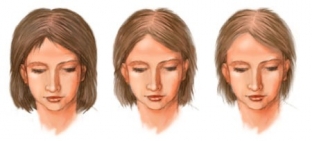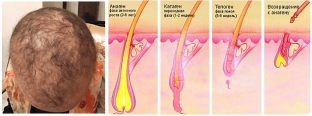Among the most common diseases that cause baldness, experts unambiguously name diffuse alopecia. On the one hand, its development can be explained by hereditary predisposition, on the other hand, there are many trigger factors that translate this predisposition into a high probability of hair loss.
A metabolic disorder that adversely affects the hair follicle does not have an unambiguous interpretation, and therefore it is very difficult to determine the direct cause of the development of baldness, and, accordingly, to choose an effective therapy.
In the structure of all hair diseases, non-scarring hair loss (diffuse alopecia) is more than 80%, i.e. is the most common cause of hair loss, affecting 30–40% of people under the age of 50. As a pronounced cosmetic defect, baldness often leads to psycho-emotional discomfort that reduces the quality of life, and causes both social problems due to restrictions in the choice of profession, employment and social prospects, and economic ones due to the duration of treatment and its high cost. Despite the long history of this problem, the issues of etiopathogenesis, diagnosis and treatment of non-scarring alopecia are still insufficiently studied, and modern terminology is confusing. The available statistical calculations on the prevalence of hair diseases are often contradictory,
Diffuse alopecia: state of the problemAccording to current publications, in recent years there has been a trend towards an increase in the number of patients with diffuse hair loss. Complaints of hair loss are often presented by middle-aged women, but it should be noted that a clear incidence rate has not been recorded. According to F. M. Meng and Yu. V. Oleinikov (2005), hair diseases reach 8% in the structure of appeals to a medical and cosmetology clinic, and the number of initial appeals over the past year has increased by 1.5 times. The true prevalence of hair diseases is much higher, since a significant number of patients do not seek medical help, considering increased hair loss as a normal condition. Patients visit a doctor with a pronounced aesthetic change, when the expansion of the parting becomes noticeable and the scalp more perceptibly (i.e., visible) shines through the hair.

Pathogeny of diffuse alopecia
The pathogenesis of non-scarring hair loss is complex and still remains poorly understood. However, it is now established that various kinds of toxic effects or metabolic disorders affect hair growth, which leads to its thinning. At the same time, we observe an increase in the ratio of vellus hair to rod hair. Etiological factors affect the hair in the anagen phase, since during this period the hair follicles have a high metabolic activity. This helps to shorten the anagen phase (growth phase) and the faster transition of the hair into telogen (shedding phase). Thus, as a result, an additional amount is added to the already existing number of hairs in the telogen stage, which leads to their abundant loss. The change in the ratio of telogen and anagen hair is caused by a failure in the processes of division and differentiation of keratinocytes, a violation of metabolic processes located in the growth zone of the hair bulb. The vascular endothelial growth factor (VEGF) is able to regulate the cycle of a mature hair follicle, which has a decrease in vascularization upon entering the catagen phase and restoration of vascularization at an early stage of anagen. This factor is synthesized by various cells, including keratinocytes and fibroblasts. VEGF has been proven to be a growth factor in dermal papilla and hair follicle cell cultures. In mature hair follicles, VEGF is found in the inner and outer epithelial sheaths of the hair root and the dermal papilla. Thus, VEGF is a molecule
 In recent years, many authors have noted the existence of a connection between alopecia and a deficiency of a number of trace elements. After all, their physical properties, shape, color, thickness, elasticity, growth rate depend on the microelement composition of hair. Hair without sufficient zinc does not grow well, without selenium and silicon, they become thinner, brittle, and an excess of silicon can increase the "wavy" hair. Copper and manganese metabolism disorders are associated with premature graying of hair. So, T. A. Malova (2005) found that all children examined by her with alopecia had a pronounced imbalance of microelements. The author established a deficiency of the following essential trace elements: iron, manganese, copper, zinc, calcium. 100% of children have a lack of selenium.
In recent years, many authors have noted the existence of a connection between alopecia and a deficiency of a number of trace elements. After all, their physical properties, shape, color, thickness, elasticity, growth rate depend on the microelement composition of hair. Hair without sufficient zinc does not grow well, without selenium and silicon, they become thinner, brittle, and an excess of silicon can increase the "wavy" hair. Copper and manganese metabolism disorders are associated with premature graying of hair. So, T. A. Malova (2005) found that all children examined by her with alopecia had a pronounced imbalance of microelements. The author established a deficiency of the following essential trace elements: iron, manganese, copper, zinc, calcium. 100% of children have a lack of selenium.
Classification of forms of diffuse alopecia
As mentioned above, the classification of the various forms of diffuse alopecia is confusing. If we follow the systematization of diffuse alopecia according to the clinical and morphological characteristics of hair loss, then it can be divided into telogen and anagen. Androgenetic alopecia is often referred to as diffuse alopecia.
Androgenetic alopecia is fundamentally different from the previous two. First, this hair loss has a typical thinning of the hair or alopecia in the frontal and/or parietal regions. Secondly, in androgenetic alopecia, the main links in the pathogenesis are the excessive content of androgens in the tissues of the body or the increased sensitivity of specific receptors to them, as well as a local disturbance of androgen metabolism. The fundamental difference between these forms of diffuse alopecia is reflected in the International Classification of Diseases of the 10th revision. According to this classification, androgenetic alopecia and non-scarring hair loss can be distinguished separately, which includes telogen and anagen hair loss.
J. Headington (1993) identifies five functional types of telogen hair loss.
Premature termination of the anagen phase is the most common reaction of follicles to the action of provoking factors. Hair follicles, which should have been in the growth phase for a long time, enter the telogen phase prematurely and the process ends with abundant hair loss 3-5 weeks after exposure to the provoking factor.
- Late completion of the anagen phase, characteristic of postpartum hair loss. Most follicles (due to hormonal changes during pregnancy) are in the growth phase and do not enter the catagen phase until the baby is born. After birth, these follicles quickly enter the catagen phase, which leads to hair loss 1-2 months after birth.
- A shortened anagen phase, which is considered idiopathic, and there is an inability to grow hair to its usual length.
- Premature termination of the telogen phase, which is characterized by a significant shortening of the resting phase, which contributes to the rapid entry of the follicle into the next growth phase.
- Late completion of the telogen phase. It is observed in people living in conditions of short daylight hours.
- Telogen effluvium baldness can occur in both acute and chronic forms. But in any case, with non-scarring alopecia, complete baldness does not occur. Acute telogen alopecia lasts less than 6 months, and then spontaneously or during therapy disappears; chronic lasts more than 6 months, sometimes for several years. Patients with chronic telogen alopecia report persistent and severe hair loss with an undulating process.
Anogen effluvium is a sudden loss of hair caused by exposure to chemical agents or radiation. In this case, the hair falls out without passing into the telogen phase. Sudden hair loss usually occurs 1 to 3 weeks after exposure to chemicals or radiation. Most often this occurs in the treatment of malignant tumors, which is carried out using radiation or cytostatic agents. In most cases, chemotherapy-induced hair loss is completely reversible. Sometimes the newly grown hair is healthier and stronger than the one that fell out.
 Types of diffuse alopecia
Types of diffuse alopecia
Several etiological factors can be identified that lead to disruption of the growth process in the hair follicle and, accordingly, the different types of diffuse alopecia can be divided.
Diffuse alopecia in infections. Diffuse hair loss can occur after influenza, malaria, infectious mononucleosis, pneumonia, brucellosis, typhoid fever, tuberculosis, syphilis, and HIV infection. With prolonged and recurrent fever, each attack causes damage to the hair follicles in the same phase of their cycle of activity. Baldness occurs 2-2.5 months after a severe attack of fever.
Drug-induced diffuse alopecia. Depending on the dose and duration of medication, anagen alopecia may develop at high doses, and telogen alopecia at low doses. The following groups of drugs can be attributed to drugs that provoke hair loss: retinoids, antiparkinsonian drugs, ?-blockers, anticoagulants, anticonvulsants, H2-receptor blockers, cytostatics.
Diffuse alopecia in deficient conditions. Iron deficiency leads to diffuse alopecia even in the absence of anemia, as do zinc, chromium, selenium, protein nutrition and vitamin B12 deficiency. A common cause is protein-calorie malnutrition. Hair roots react to protein deficiency very quickly: hair acquires signs of dystrophy - the diameter of the hair decreases, the growth rate decreases markedly. Secondary protein deficiency develops with malabsorption syndrome, enteropathy, disorders of absorption and cleavage processes, which is observed in various diseases of the gastrointestinal tract.
Diffuse alopecia in chronic diseases. The classic causes of hair loss are endocrine disorders, in particular hyper- and hypothyroidism. Eyebrow damage is typical in hypothyroidism. The same symptom occurs in syphilitic hair loss and atopic dermatitis (Hertoge's sign). The following diseases can also be distinguished: erythroderma, psoriasis, systemic lupus erythematosus, etc.
Psychosomatic alopecia. Abundant hair loss was observed during the wars: it was the result of stress, surgical interventions, accidents.
Idiopathic chronic diffuse alopecia. In some patients, it is often difficult to identify the causes of hair loss, and therefore the diagnosis of "idiopathic alopecia alopecia" is made. However, during the diagnosis, one should not forget about the presence of androgenetic alopecia. V. P. Adaskevich et al. (2000) indicate that in almost 40% of patients with complaints of diffuse hair thinning, a thorough examination reveals an increased level of androgens in the blood serum.
 Treatment of diffuse alopecia
Treatment of diffuse alopecia
When complaining of hair loss, a diagnostic program is traditionally prescribed to identify pathologies from the thyroid gland, central nervous system, diseases of the ovaries and adrenal glands, liver, immune system, etc. in order to establish the true cause of baldness. Often, treatment begins with external therapy, which consists in applying lotions, balms, masks, gels to the scalp, preparations containing alcohols, red pepper tinctures, ether, and electrophoresis of biologically active substances is prescribed. For oral administration, doctors recommend vitamins C, PP, A, in the form of injections - vitamins B6, B1, B12. Long-term zinc intake is recommended (multivitamin complexes, dietary supplements, the composition of which is specially selected for hair treatment).
All these methods are well known to practicing dermatologists and cosmetologists, but we would like to focus on more modern medicines for the treatment of hair loss.
Studies in recent years show the effectiveness of homeopathic medicines in the treatment of various types of alopecia. Complementing traditional treatment, homeopathic medicines expand the possibilities of treatment. Homeopathy, which has existed for more than two hundred years, has proved to be an effective therapeutic method, with almost no side effects. Homeopathic medicines in a special way activate the body's reserve forces and belong to the so-called "regulatory" therapy. The effect of the use of these drugs is the result of the interaction of the substances that make up their composition. Common to them is the regulatory and stimulating effect due to the inclusion of autogenic mechanisms in therapeutic processes. According to the basic principle of homeopathy, homeopathic substances in low potencies act mainly on the physical level on the corresponding organ, focusing on the symptom, which allows them to have a targeted effect in a specific disease.
Among the modern topical drugs recommended for the treatment of baldness, minoxidil, aminexil and tricosaccharide are currently used. The most interesting substance is the tricosaccharide. An important quality of this medicinal substance is a differentiated approach to the treatment of alopecia in men and women. Tricosaccharide has the ability to penetrate into the inner layers of the hair follicle and regulates the exchange of nutrients between blood and tissues.
Thus, diffuse alopecia is a multifactorial disease, which is determined by the polygenic system that determines hereditary predisposition, and trigger factors that reduce the threshold of this predisposition. The variety of theories of metabolic disorders and their effect on the hair follicle indicates the complexity of the pathogenesis of this disease, which sometimes explains the lack of effectiveness of therapy.
According to http://www.lvrach.ru/
Alopecia treatment with mesoscooter
Alopecia areata or diffuse alopecia with adequate medical therapy are one of the main indications for microneedling of the scalp. Using traditional Eastern methods of acupuncture, micro-punctures of the dermaroller in the scalp area increase blood flow, which contributes to the saturation of the hair follicles with nutrients and is the strongest stimulator of the growth of "sleeping" bulbs:
Biofibre hair implantation is an effective, safe and yet simple surgical procedure that allows you to achieve natural hair density. Biofibre hair implantation is recommended for scalp hair loss and alopecia. Due to the different lengths of the thread (from 15 to 45 cm), the procedure is indicated for both men and women, regardless of age, as well as a rejuvenating procedure or when it is necessary to enhance the aesthetic results of other hair restoration methods.





